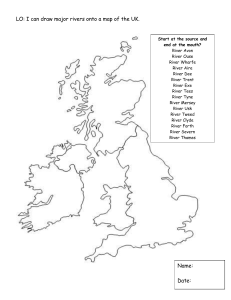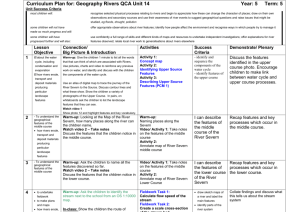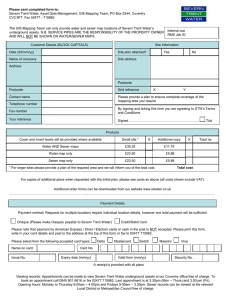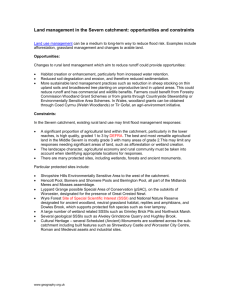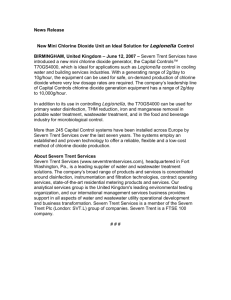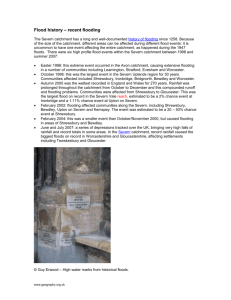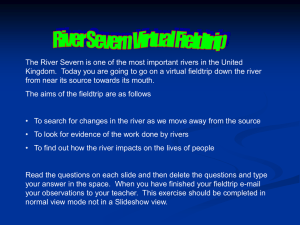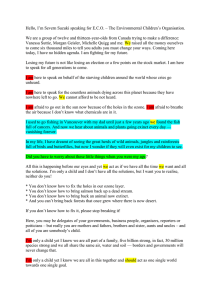SevernAndTheDaySheSilencedTheWorld ESLTeachersGuide USA
advertisement
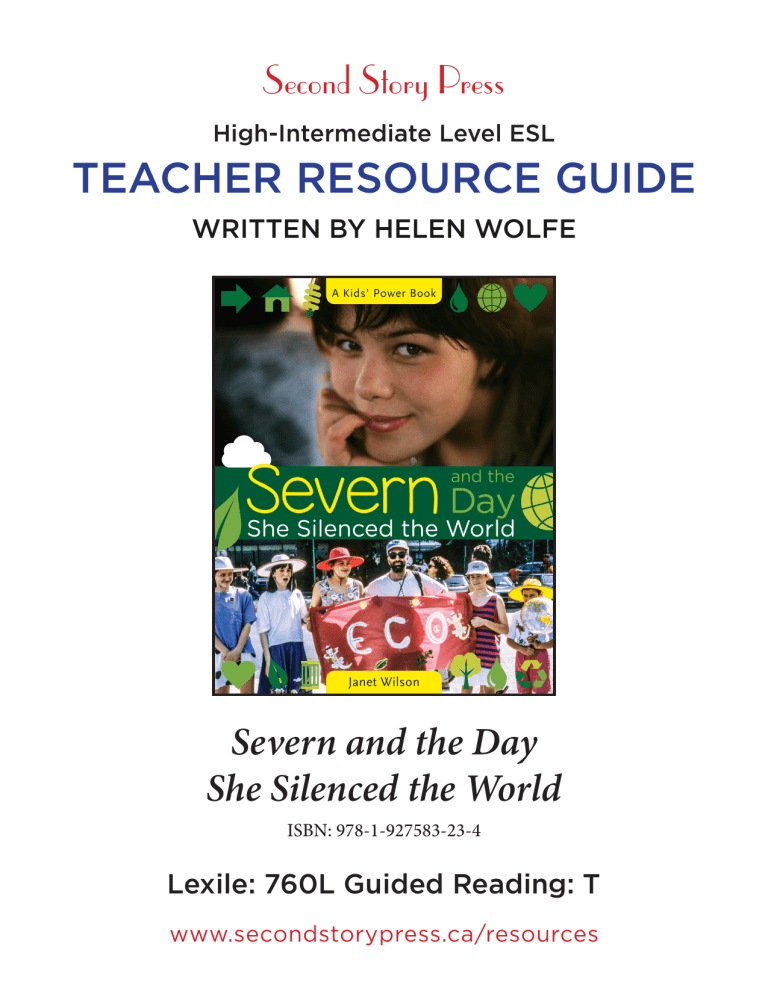
Second Story Press High-Intermediate Level ESL TEACHER RESOURCE GUIDE WRITTEN BY HELEN WOLFE Severn and the Day She Silenced the World ISBN: 978-1-927583-23-4 Lexile: 760L Guided Reading: T www.secondstorypress.ca/resources Book Summary Severn and the Day She Silenced the World is the true story of how Severn Cullis-Suzuki, the daughter of Canadian environmentalists David Suzuki and Tara Cullis, embarked on a mission to protect the rainforests. Throughout their many travels, Severn’s parents had instilled a love of nature and respect for diverse cultures in Severn and her younger sister, Sarika. By the age of nine, Severn had been to the Amazon and witnessed first hand the impact of man’s destruction on that environment, its wildlife, and its human inhabitants. That visit inspired Severn and four friends to create the Environmental Children’s Organization (ECO), an advocacy group that produced a newsletter, participated in rallies, protests, and fundraising events and made speeches on these key issues. ECO’s purpose was to give children a voice to express their concern for environmental issues. The Environmental Children’s Organization spoke out about how individuals, governments, and businesses are destroying the earth, water, and air. Also, they personally witnessed the direct relationship between a polluted environment, poverty, and homelessness. In 1991, Severn found out that the next year the United Nations would be sponsoring the first Earth Summit where world leaders and activists would come together to discuss and implement policies to protect the environment. Severn and the ECO became committed to raising the thousands of dollars needed to attend the summit in Rio de Janeiro, Brazil. This event gave the ECO girls a platform where they shared their views with attendees from around the world. However, Severn’s moment came near the end of the Summit when she was unexpectedly called up to make an impassioned plea, on behalf of children everywhere, for world leaders to treat environmental crises with the urgency they deserved. Severn and the Day She Silenced the World , a “Kid’s Power Book,” is a work of narrative non-fiction written by Janet Wilson in 2014. The details are all true, while conversations between characters have been reconstructed by the writer. This 208-page chapter book integrates text about at-risk cultural groups and endangered wildlife species with newspaper articles, graphics, and photographs of Severn and the ECO kids. Originally written for young adults from nine to thirteen years old, this book would also be appropriate for middle school students who speak English as a Second Language at the Intermediate level, and as a core text for ESL DO secondary school credit courses. The themes explored in the book are environmentalism, advocacy, empowerment, and social justice. It could also be used in a middle school social studies and geography programs and secondary school courses on earth sciences and world issues. Severn and the Day She Silenced the World 1 PART A Pre-reading and Media Literacy Activities ACTIVITY 1 Class Discussion on the Environment This is a focussed discussion on environmental issues designed to introduce and clarify key vocabulary and issues explored in the book. Students are also encouraged to express their opinions on environmental issues. If you have a computer lab available, you could do this activity as a class brainstorm on “wall wisher,” where all the students can share their answers which will appear on the computer screen. Give them the discussion worksheet that follows: Severn and the Day She Silenced the World 3 ACTIVITY 1 DISCUSSING THE ENVIRONMENT Directions: a. Organize yourselves in multicultural groups of four to six students. b. Discuss each of the following questions. Take your own notes. c. Please do not use a dictionary or technology to answer these questions. Express your ideas in your own words. d. We will be taking up your answers as a class. 1. What is a good definition of the word “environment”? ________________________________ ____________________________________________________________________________ ____________________________________________________________________________ 2. What are the different elements of our Earth that make up the environment? ______________ ____________________________________________________________________________ ____________________________________________________________________________ 3. What is environmentalism? How are the two words “environment” and “environmentalism” related? _____________________________________________________________________ ____________________________________________________________________________ ____________________________________________________________________________ 4. If you immigrated from another country, where do you think the environment was cleaner: here or in your first country? Give reasons for your choice. If you don’t remember these details about your first country, ask your parents for help._________________________________________ ____________________________________________________________________________ ____________________________________________________________________________ Severn and the Day She Silenced the World 4 5. What proof do you have that the environment you’re living in is unsafe or unclean? _________ ____________________________________________________________________________ ____________________________________________________________________________ 6. What are some countries or places in the world where you believe that the environment is very clean? Why do you have that impression? __________________________________________ ____________________________________________________________________________ ____________________________________________________________________________ 7. What do the words “polluted” and “pollution” mean? _________________________________ ____________________________________________________________________________ ____________________________________________________________________________ 8. With your group, brainstorm the causes of pollution to air, soil and water. Create a point-form chart that looks like this. WHAT CAUSES POLLUTION IN THESE AREAS? 9. AIR WATER SOIL smoke from cars chemicals from factories chemical sprays for plants What kinds of illnesses can people get when they live in an unclean environment? __________ ____________________________________________________________________________ ____________________________________________________________________________ 10. What things can ordinary kids or adults do to help or protect the environment? ____________ ____________________________________________________________________________ ____________________________________________________________________________ Severn and the Day She Silenced the World 5 ACTIVITY 2 Group Discussion of Environmental Issues This is an alternative to Activity 1 using visuals in a multi-leveled classroom or to differentiate instruction for students requiring visual cues to encourage discussion. You will need to prepare several large envelopes with visuals of both clean and polluted environments. Each group can work with different pictures. Give your students the directions that follow. Severn and the Day She Silenced the World 6 ACTIVITY 2 Discussing Environmental Issues Directions: 1. Make multicultural groups of four to six students and sit together at a table. 2. Open the envelope that has pictures about the environment. 3. First, put the pictures into two piles: one pile has pictures showing a clean, healthy environment and the other a polluted, unhealthy environment. 4. Discuss your reasons for putting the pictures in their correct piles. 5. Write a one or two sentence caption for each picture describing the picture and the reason for what you are describing. For example: This sky is very polluted because the chimneys from the factories are releasing black smoke containing chemicals into the air. 6. After you’re finished your discussion, your group will do a short presentation for the class. Severn and the Day She Silenced the World 7 ACTIVITY 3 Mapping the Story Provide the students with their own blank world maps. Have them use either an atlas or technology to find and label the equator, the continents, and the oceans. Then, they can use the map to track and label Severn’s travels throughout the book starting with her home in Vancouver. On a larger wall map in the classroom. use pins or markers to label all of the locations mentioned in the book. ACTIVITY 4 Computer Research: David Suzuki Severn’s parents, David Suzuki and Tara Cullis, are environmentalists who were highly influential in making their children aware of key environmental issues when they were very young children. The students can do the next four activities either before or after reading the book. Severn and the Day She Silenced the World 8 ACTIVITY 4 Researching David Suzuki Directions: a. Do this research on your own or with one partner only. b. Use the Internet or the subscription databases available at your school. c. Find and read one or two resources about David Suzuki. Use documents that are not too difficult for you to read and understand. d. Answer the following questions about David Suzuki’s life and work. 1. When and where was David Suzuki born? __________________________________________ ____________________________________________________________________________ ____________________________________________________________________________ 2. What terrible racist experience did David and his family have when he was very young? Why did they have these experiences? ____________________________________________________ ____________________________________________________________________________ ____________________________________________________________________________ 3. What education did he have? List all of his qualifications and the subjects he studied. ________ ____________________________________________________________________________ ____________________________________________________________________________ 4. What has been his lifelong passion? List the different kinds of work he’s done. ______________ ____________________________________________________________________________ ____________________________________________________________________________ Severn and the Day She Silenced the World 9 5. What is “The Nature of Things”? What kind of program is it? How long has it been on television? ____________________________________________________________________________ ____________________________________________________________________________ ____________________________________________________________________________ 6. What is some work he has done with his children and his wife, Tara Cullis? ________________ ____________________________________________________________________________ ____________________________________________________________________________ 7. What are some ways that he educates people using the media? __________________________ ____________________________________________________________________________ ____________________________________________________________________________ 8. What are some of his awards and honors? __________________________________________ ____________________________________________________________________________ ____________________________________________________________________________ Severn and the Day She Silenced the World 10 ACTIVITY 5 David Suzuki Fact Sheet Using the information you have researched in Activity 4, create a fact sheet on David Suzuki. You may create it online or free hand. Your details should be under these categories and in point-form style. a. Early Life b. Education c. Life’s Work and Passion d. Awards and Accomplishments e. Quotes You should also include a few pictures of him during different times of his life, and include a recent picture. Your assignment will be evaluated for Content, Organization, Language Skills, and Visual Appeal or Attractiveness. Severn and the Day She Silenced the World 11 ACTIVITY 6 Researching Tara Cullis-Suzuki Give the students the same directions for researching and recording facts for Tara Cullis-Suzuki as were given in Activity 4. ACTIVITY 7 Tara Cullis–Suzuki Fact Sheet Give the students the same directions for creating a fact sheet for Tara Cullis Suzuki as were given in Activity 5. ACTIVITY 8 Guided Viewing: Severn and the Day She Silenced the World The students should see the video of the speech that Severn made at the Earth Summit in Rio de Janeiro, which is the climax of the book. The speech is easily found on YouTube. Give the students this guided viewing activity sheet before playing the speech. If you do not wish to give away the climax before reading the book, you could do this after reading the book as an extension or enrichment activity. Severn and the Day She Silenced the World 12 ACTIVITY 8 Guided Viewing: Severn and the Day She Silenced the World Directions: a. We are going to watch the speech that Severn Cullis-Suzuki made at the Earth Summit in 1992. b. As we are watching, answer the questions using point-form notes. c. Then we will have a class discussion about the speech. 1. What information does Severn give about herself and the Environmental Children’s Organization? ________________________________________________________________ ____________________________________________________________________________ ____________________________________________________________________________ 2. What accurate facts about the environment does she talk about in her speech? Make a list of those facts. _______________________________________________________________________ ____________________________________________________________________________ ____________________________________________________________________________ 3. Would you describe the tone of her speech as formal or informal? Give reasons for your choice. What other words would you use to describe the tone of her speech? _____________________ ____________________________________________________________________________ ____________________________________________________________________________ 4. She repeats the sentence “I’m only a child” several times in her speech. In your opinion, why does she repeat that sentence? What would be the effect of those words on her audience, which was mostly made up of adults? ______________________________________________________ ____________________________________________________________________________ Severn and the Day She Silenced the World 13 ____________________________________________________________________________ 5. What did she accuse world leaders of? _____________________________________________ ____________________________________________________________________________ ____________________________________________________________________________ 6. How did Severn show the ways children are directly affected by living in an abused or neglected environment? ________________________________________________________________ ____________________________________________________________________________ ____________________________________________________________________________ 7. What does the word “defiant” mean? Why did Severn’s tone become defiant near the end of her speech? _____________________________________________________________________ ____________________________________________________________________________ ____________________________________________________________________________ 8. Near the end of her speech, Severn said, “Make your actions reflect your words.” What did she mean by these words? What is she asking these world leaders to do? _____________________ ____________________________________________________________________________ ____________________________________________________________________________ 9. Severn’s speech was less than five minutes long but was very effective. Make a list of the characteristics or qualities of good speechmaking. Include points about content, language use, organization , eye contact, body language, voice control, and emotional impact. ____________ ____________________________________________________________________________ ____________________________________________________________________________ Severn and the Day She Silenced the World 14 ACTIVITY 9 Elements of Storytelling Use this cloze activity as a review of the elements of storytelling, which students will need to know in order to analyze the book. Severn and the Day She Silenced the World 15 ACTIVITY 9 Elements of Storytelling Review This is a list of terms that we use when discuss stories that we read or watch. protagonist setting climax theme plot fiction characters conflict antagonist rising action non-fiction symbolism These are the definitions of these terms. Without using a dictionary, write the correct term beside its definition. 1. A series of events in the story building up to the most exciting part. ___________ 2. A story or any reading that has true facts or information. ___________ 3. A sign, picture, image, graphic, or color that has a bigger meaning. ___________ 4. Any problem, disagreement or tension that a character can have with himself, another character, with society, or with nature. ___________ The time, place and situation that a story begins in. A story may have more than one. ___________ The main character who usually changes the most from the beginning to the end of the story. ___________ 7. The events of a story that are usually in time order. ___________ 8. The main idea, message, lesson or moral of a story. A story may have more than one. ___________ A person in a story who uses actions or words to go against the main character or tries to stop the main character in some way. ___________ 5. 6. 9. 10. The people in a non-fiction story. In fiction they could be animals or supernatural creatures. ___________ 11. The turning point or most exciting part of the story. ___________ 12. A story that comes from the creative imagination of a writer, like a short story or novel. ___________ Severn and the Day She Silenced the World 16 PART B Reading Activities ACTIVITY 10 Chapter Questions These questions ask students to identify significant plot details and analyze the elements of literature including characterization, setting, theme, conflict, climax, and symbolism. They can be used for oral discussion and review, and evaluated oral and written assignments. Severn and the Day She Silenced the World 18 ACTIVITY 10 Chapter Questions Chapter 1: The Edge of the World (pages 3–9) 1. Where does the story begin? 2. Draw two separate family diagrams that show the characters in this chapter and their relationship to each other. 3. Describe the Kapayo people of the Amazon rainforest. 4. Why were the Kapayo family coming to visit David and his family? 5. Why did Severn describe her father as “just like a big kid?” (page 6) 6. How do we know that Severn loved nature? Chapter 2: What’s Your Excuse? (pages 10–16) 7. Just from looking at the chapter title, predict theme of the chapter. 8. What is the setting of the chapter? 9. Severn’s father, David Suzuki, is an environmentalist. What is the job of an environmentalist? 10. Paiakan and his family are from the Amazon rainforest. Where is it? 11. David Suzuki is the host of a program called “The Nature of Things.” What is it about? How long has it been on television? 12. David Suzuki said, “The Amazon rainforest is a treasure trove of plants and wildlife facing extinction.” (page 11) What did he mean? 13. Why did Paiakan, the Kapayo chief, need to leave his village? Give several reasons. 14. Why did Severn believe that “Nature is more important than money!”? (page 14) Do you agree with her? Give reasons for your opinion. 15. What were some similarities between First Nations communities and the Kapayo people? 16. Why did Severn complain when her class was studying about First Nations people in school? Severn and the Day She Silenced the World 19 Chapter 3: The Best Show–and-Tell Ever (pages 17–23) 17. Why did Sarika want to bring Oe and Tania to school for “Show and Tell”? 18. What objects did the Kayapo family show to the kindergarten class? Why do you think they chose those particular objects? 19. How was Severn’s childhood different from the lives of her classmates or other children her age? 20. How was Severn’s relationship with nature different from friends’ relationship? 21. Why did the Kapayo family decide to return to their home? Chapter 4: Back in Time (pages 24–30) 22. Why did the Kapayo people cry when Severn’s family arrived in their village? 23. Why does Severn call herself and her family “time–travelers”? (page 28) 24. What did Tara mean when she called the villagers’ lives “idyllic”? 25. What proof did Sarika and Severn have that the water near their home in Vancouver was polluted? Chapter 5: Fishing on the River Zinho (pages 31–37) 26. Why couldn’t Tara and her daughters go fishing with the men and boys? Why did Severn think that their rules were unfair? 27. Why did the sisters get to go fishing the next day? 28. What were several differences between Severn’s home in Vancouver and the Kapayo village? In her opinion, which home was better for the earth? Why? Chapter 6: Onca-Pintada! (pages 38–43) 29. How are the plants in the rainforest helpful to people all over the world? 30. Read the paragraph on page 39 that begins, “Severn was giddy with the intensity of the jungle.” What does “giddy” mean? Why did Severn have this feeling about the jungle? 31. Describe some of the dangers of living in a rainforest. Chapter 7: Bad Omens (pages 44–48) 32. What did the celebration of the women’s festival in the village tell us about the status of women in the Severn and the Day She Silenced the World 20 Kapayo culture? 33. What happened to two people living in the village? 34. How was the way that the Kapayo dealt with dead people different from the ways of most other countries? Why did Severn think that the Kapayo way was “pretty natural”? (page 47) 35. Paiakan said “The moon is sick and my people are very frightened.” (page 47) To Paiakan and the Kapayo people, what is the connection between the phases of the moon and human nature? 36. What did David mean when he said that the Kapayo thought his family brought “bad omens?” (page 48) 37. Why did Severn feel “conflicted about her culture and confused about being in Aucre?” (page 48) What kind of conflict was she experiencing? Why did she have it? Chapter 8: Smoke Signals (pages 49–54) 38. Why did David give the Kapayo some of the family’s supplies before they left the village? 39. Why did David say, “Our world represents a threat to their culture, their home, and their way of life?” (page 51) 40. Why was everyone upset by the fires that were deliberately set in the rainforest? 41. Why were the people of Rendencao not as “clean, happy or well-nourished” as the people in Aucre? Chapter 9: The First Step (pages 55–60) 42. What is the setting of this chapter? 43. How will the burning of the rainforest affect medical cures in the future? 44. Why was Severn excited by the kids who have made important contributions to the environment? How were their contributions motivating her? 45. Why did Severn feel that “she was taking the first step on a journey”? (page 60) Chapter 10: Stop Wrecking the Planet (pages 61–66) 46. Why did the ECO organize a school craft fair? 47. Who is Jeff Gibbs? How could his experience as an environmentalist be helpful to Severn and the ECO? 48. In your opinion, did Severn, Tove, Michelle and Vanessa take their responsibilities in the environmental club seriously? Give your opinion and reasons to support it. Severn and the Day She Silenced the World 21 49. Severn’s mother said about Jeff, “He’ll be a wonderful mentor and teach you a lot about activism.”(page 65) What did she mean? 50. What would be Doug Ragan’s contribution to the ECO? 51. What is ozone depletion? How does it affect the lives of people who live in Australia and New Zealand? Chapter 11: Endangered People (pages 67–74) 52. What kind of event is a ‘benefit’? (page 67) 53. Where is Borneo? 54. What does “extinct” mean? (page 68) Why did Severn think that groups of people could become extinct? 55. Why would the basic human right to clean water be violated for people in poor countries? 56. What would be the ECO’s first fundraising project? 57. Read pages 68-71. In your opinion, was the ECO’s meeting successful? Give your opinion and reasons to support it. 58. What do you think about ECO’s first school assembly? 59. What proof is there that ECO’s first fundraising event was successful? Chapter 12: Hopeless (pages 75–79) 60. What was going to happen at the Earth Summit in Brazil? 61. Why did Severn think that ECO should attend the summit? 62. What were three reasons that David thought that going to the Earth Summit was a “crazy idea”? (page 76) 63. Why was Tara upset when Sarika said that saving the Earth was “hopeless”? (page 77). What did Tara realize about her children? 64. What advice did David give his children? Do you agree with his advice? Why or why not? Chapter 13: A Conscience to Adults (pages 80–86) 65. Severn said to Mr. Tomkins, “We want to be a conscience to adults.” (page 82) What did she mean? 66. What did Severn hope that Mr. Tomkins would do if she told him all about the activities of the environmental club? 67. What did ECO do at their next meeting? Severn and the Day She Silenced the World 22 68. At the meeting, Tove said, “What we’ve collected so far is just a drop in the bucket.” (page 84) What did she mean by this idiom? 69. The last lines of the chapter are, “Maybe their drops in a bucket could make a difference after all.” (page 85) What did she mean? What did the drops in a bucket represent to her? Chapter 14: The Emperor Has No Clothes (pages 87–93) 70. The title of this chapter is the title of a well-known fairy tale. What is the main theme of the story? 71. Why are the girls writing articles for a newsletter? 72. What is a “credit union”? (page 89) How could it help the ECO get to the Earth Summit? 73. Why did David say that he was proud of Severn and the ECO? 74. Why did Severn’s mother compare the ECO going to the Earth Summit to the boy who told the emperor that he wore no clothes? Explain the meaning of the comparison. 75. What two things did Severn’s parents agree to do? 76. What warnings and restrictions did David place on Severn going to the Earth Summit? Chapter 15 : Pie in the Sky (pages 94–100) 77. What was the most overwhelming challenge that Severn and her friends faced in going to the Earth Summit? 78. Why did Tara suggest that the ECO kids plan an event at the Vancouver Planetarium? What was the purpose of the event? Chapter 16: Help Us Change the World (pages 101–108) 79. How did the ECO girls prepare for the benefit at the planetarium? 80. Who is Raffi? Why would he be an important ally in their cause? 81. Why were the girls’ presentations effective? 82. What proved that the benefit was a successful event? Chapter 17: The Elephant in the Room (pages 109–114) 83. Why was Severn nervous about the important decision she had to make? Severn and the Day She Silenced the World 23 84. What sacrifice did Tove make at the planning meeting? What personal qualities did her action show? Chapter 18: On the Road (pages 115–122) 85. Why could we say that Rio de Janeiro is a city of contrasts? 86. Why would the ECO girls, who all lived in Vancouver, be shocked by the favelas? 87. What are several environmental, social and safety differences between Rio and Vancouver? 88. Why did David refer to Rio as a “raging inferno”? What did he mean? Chapter 19: Attracting Attention (pages 123–130) 89. Why weren’t there any First Nations people at the Global Forum? According to David, why was this unfair? 90. Why did so many people and international media visit the ECO booth? 91. The reporter told the girls some disturbing information about people in the favelas. What did that information suggest about the Brazilian government? 92. Why do you think the girls accepted the reporter’s invitation to go to the favelas and the protest march? 93. Why would killing animals for their meat be harmful for the rainforest? 94. What did Michelle do with the leftovers from their restaurant dinner? 95. What did that action show about her personality? Chapter 20: Puzzle Pieces (pages 131–135) 96. What was Raffi’s contribution to the Earth Summit? 97. What were Severn’s mixed feelings as she marched in the protest? 98. Why were the girls disappointed by the Minister of the Environment’s visit to their booth? Chapter 21: This is Our World, Too (pages 136–144) 99. How did the ECO kids impress both adult visitors to the Summit and other young people who heard about them? 100. David arranged for the girls to speak at the Consulate. What is a consulate? Why would the girls want to speak there? 101. Why did the girls feel more optimistic after the Minister of the Environment spoke to them? Severn and the Day She Silenced the World 24 102. Why were the girls excited by the young people who prepared a “Youth Statement” for the Summit? 103. Explain why a riot nearly broke out at Rio Centro. How was the Brazilian government at least partly responsible for the riot? Chapter 22: Shame! Shame! (pages 145–152) 104. Why was it important for the ECO kids to speak at an event hosted by Maurice Strong? 105. The theme of the event where they spoke was “education and ethics.” (page 146) What is the meaning of “ethics”? How are education and ethics related? 106. Paiakan may have been arrested because of “trumped-up charges.” What do you think that means? 107. Why would the governments of some countries try to stop activists? 108. In your opinion, why didn’t Severn’s parents try to hide real-life challenges from her? 109. What proved that the speeches had an impact? Chapter 23: Dreams and Hopes (pages 153–160) 110. The ECO girls took a tour of a Rio slum. In your own words, what is a slum? 111. In your own words, summarize the disturbing information that the ECO girls learned about living in a slum and the lives of street kids in Rio. 112. What did the street kids think would solve all of their problems? Why would they think that way? 113. How did their visit to the slum improve the ECO kids’ understanding of the connection between child poverty and abusing the environment? 114. Reread page 159. Create a diagram or graphic text that expresses the important ideas the ECO kids described to the reporter. Chapter 24: It Doesn’t Seem Fair (pages 161–166) 115. Why was Michelle Quigg able to explain the differences between North and South America? 116. Create a chart and graphic organizer to show the differences between the the lifestyles of North and South Americans. (pages 161-163) 117. What do you think Michelle means when she uses terms like “The First World, the Second World and the Third World”? (page 163) Which countries are in each world? Severn and the Day She Silenced the World 25 118. Michelle said “I’ve only ever seen one World.” (pages 163-164) What important idea was she expressing? Chapter 25: Telling the World (pages 167–174) 119. What surprise opportunity did Severn get? 120. Why and how did the other ECO girls need to help her? 121. Why were there armed soldiers guarding the entrance of Rio Centro, the building where Severn was going to make her speech? 122. Why wasn’t Severn upset that she had a small audience for her speech? Chapter 26: I’m Only a Child (pages 175–182) 123. How do we know that many world leaders were very concerned about the the environment? 124. Make a point-form list or chart of all of the environmental issues scientists and advocates spoke about at the summit. 125. By the tenth day of the summit, how was everyone feeling about these issues? Why were they feeling this way? 126. Look at the first paragraph of Severn’s speech on page 176. She started with the words, “Coming up here today, I have no hidden agenda.” What did she mean? 127. In the first paragraph, Severn starts many sentences with the words, “I am here to speak…” Why would she repeat the same phrase several times? Why would repetition be an effective way public speaking technique? 128. Severn uses the pronoun “I” in her speech a lot. Usually when we speak about important world issues, we don’t use personal pronouns. Why does using the word “I” so many times in her speech make it more effective? 129. What were the main themes of her speech? 130. What are words you would use to describe the tone of the speech? Give some reasons for your choices. 131. Severn said, “You teach us not to fight with others, to work things out, to respect others, to clean up our mess, not to hurt other creatures, to share—not to be greedy. Then why do you go out and do the things you tell us not to do.” (page 180) What kind of accusation is this? Do you agree with Severn? Why or why not? 132. Why was the audience of very influential adults so affected by her speech? Severn and the Day She Silenced the World 26 133. The man who congratulated Severn was Al Gore. Why was his approval so important? (If you’re not sure, use the Internet or your school’s subscription databases to research some information about him.) Epilogue (pages 183–186) 134. What is the reason that an author would write an epilogue? 135. Why would the author give the reader the text of Maurice Strong’s speech right after reading Severn’s speech? 136. What did Mr. Strong think about Severn’s speech? 137. If you were in the audience listening to the speech, what would be your emotional reaction? Give reasons for your answer. 138. What proved that the Earth Summit of 1992 was successful? Give several reasons. 139. Are you or anyone else you know an activist for environmental issues? If so, what kind of work do you or that person do? Severn Says (pages 193–195) This is an afterword written by Severn Cullis-Suzuki more than twenty years after she delivered her speech to the Earth Summit and it become immortalized on YouTube. In it Severn gives her perspective on the events that made her and ECO an internationally known youth movement. 140. Look at the date at the bottom of the bottom of page 195. What was Severn’s age when she wrote this? 141. Why does she say that her speech “remains relevant and poignant even today.” (page 193) 142. How do we know that Severn continued to care about environmental issues? 143. What do you think a “youth think-tank” could be? (page 194) 144. Severn says “I’ve committed my life to advocate for intergenerational justice, long-term sustainability, and awareness of the interconnection between culture and environment.” (page 195) What do you think all of these subjects mean? 145. Why does Severn think her speech has become so famous? 146. What words would you use to describe the tone of Severn’s message? Give some reasons for your choices. Severn and the Day She Silenced the World 27 Activity 11 SIMILES IN THE STORY The book contains many examples of figurative language. This activity requires students to identify the meaning of the similes used in the story. If your students are not familiar with similes, introduce them to this figurative language using activities readily available in textbooks or on the Internet. (After the students have completed the exercise, you could have different groups each present a few of the answers. Emphasize that answers will not be identical and that students can use different words to express similar ideas) Severn and the Day She Silenced the World 28 ACTIVITY 11 Similes in the Story A simile is one kind of figurative language that writers use to make their language more descriptive and colorful. It is used to compare two unlike people, actions, or situations. A simile uses words such as “like” or “as” to make the comparisons. Examples: a. Jeff ran like the wind to win his road race. b. Emilia shook like a leaf before she made her speech in front of the class. c. My huge dog is as gentle as a lamb and would never hurt anyone. These are examples of similes used in the story and the page references where they are found. Find the simile in the text and then write a short definition on the line. The first example is done for you. 1. I feel like I’m at the edge of the world. (page 3) excited to be in faraway, natural place 2. Severn loved how her dad became so excited __________________________________ with anything to do with the natural world— just like a big kid. (page 6) 3. The trees seemed to roll below them like __________________________________ ocean waves. “It’s like a beautiful green sea.” (page 26) 4. It’s (villagers watching them) like we’re ___________________________________ their morning cartoons. (page 31) 5. Good intentions are like pebbles tossed ___________________________________ in a pool. (page 73) Severn and the Day She Silenced the World 29 6. Word of ECO spread like ripples. ___________________________________ (page 73) 7. Severn felt something heavy in the car, like the ____________________________________ gray clouds hanging over the road ahead. (page 77) 8. If children were to speak to leaders about the _____________________________________ long-term implications of their decisions, people might listen—like the little boy who told the emperor he wasn’t wearing clothes. (page 91) 9. “Sev, if you think we can raise thousands more ____________________________________ you are nutty as a fruitcake, certifiably insane, crazy as a loon, fruit loopy” (page 95) 10. A heavy silence filled the room like an ____________________________________ elephant. (page 111) 11. It’s (Rio de Janeiro) like a sea of many ____________________________________ colors. (page 115) 12. boxy shacks, that looked as if a huge, _____________________________________ dirty quilt had been dropped on part of the city. (page 116) 13. Morgan laughed nervously, “I feel like a ____________________________________ salmon swimming upstream.” (page 116) 14. They were stacked haphazardly one on _____________________________________ top of another climbing up the steep hills, looking as if a strong wind might topple the the homes like a stack of cards. (page 117) 15. Rio is like a raging inferno. (page 120) _____________________________________ Severn and the Day She Silenced the World 30 16. She (Severn) was like a small piece of a ______________________________________ gigantic puzzle—and every piece was just as important as all the others. (pages 131-132) 17. He (the Minister of the Environment) _______________________________________ treated us like cute little girls. (page 135) 18. A boy dressed only in shorts stiff with dirt said, _____________________________________ “The police rounded us up like dogs and moved us here.” (page 154) 19. Severn turned to Morgan. Behind her expression, __________________________________ it seemed as if hamsters were running inside wheels in her brain. (page 169) 20. Losing my future is not like losing an election __________________________________ or a few points on the stock market. (page 176) Severn and the Day She Silenced the World 31 PART C Writing Activities ACTIVITY 12 Graphic Organizer: Creating a Character Chart This activity requires students to create a chart that is a graphic organizer to prepare them to write a character sketch paragraph or an essay. Give the students the directions that follow. Severn and the Day She Silenced the World 33 ACTIVITY 12 CREATING A CHARACTER CHART Directions: 1. Work in groups of four to six students. 2. Here is your assignment. Severn Cullis-Suzuki is the protagonist of Severn and the Day She Silenced the World. Choose four of her most important characteristics and give examples of those characteristics from the story. Complete the character chart below. One example is given to help get you started. Severn’s Character personal qualities proof from story 1. sensitive to people’s feelings a. understood her father was sad about marine life disappearing (page 7) Severn and the Day She Silenced the World 34 ACTIVITY 13 Character Sketch Have the students use the graphic organizer that they created in Activity 12 to write a character sketch of Severn. If they need a review of paragraph writing and organization, use any of the resources from a text or available on the Internet. Severn and the Day She Silenced the World 35 ACTIVITY 13 Creating a Character Sketch: Severn Cullis-Suzuki Severn Cullis-Suzuki was a young girl whose personality helped her to become an environmental activist. Write a character sketch that describes three of her most important character traits. For each trait that you name, give at least one specific detail or example from the story of that quality. Make sure that your paragraph (8-10 sentences) has all of these parts. 1. an interesting title 2. a topic sentence that introduces your topic 3. a body that includes 3 main points, supporting details and examples 4. a concluding sentence that summarizes your topic and adds an opinion or interesting closing idea Your paragraph will be evaluated for content, organization, and writing skills. Severn and the Day She Silenced the World 36 ACTIVITY 14 Character Essay This assignment can be used as a CPT or Culminating Performance Task for an ESL DO credit course. Before assigning this activity, make sure that your students have had instruction and review of essay writing and organization. Severn and the Day She Silenced the World 37 ACTIVITY 14 Character Essay of Severn-Cullis Suzuki Severn Cullis-Suzuki was a young girl whose unique personal qualities helped her to become an environmental activist who spoke at an important Earth Summit. Write a five-paragraph essay that describes three of her significant character traits. Your essay should have these components: 1. an interesting title 2. an introduction (3-5 sentences) that has an interesting opening statement, a clear thesis statement, and your three main points 3. 3 body paragraphs (6-10 sentences each) describing your main points, and give details and examples to support those points 4. a conclusion (3-5 sentences) in which you restate your thesis, restate your main points, and give a closing statement that presents an interesting or unique opinion or idea. Your essay will be evaluated for content, organization and writing skills. Severn and the Day She Silenced the World 38 PART D Extension/Enrichment Activities ACTIVITY 15 Starting a Class or School Environment Club If your school doesn’t already have one, start a club in which students can express their concern for environmental protection and begin activism in the school or community. Depending on the size, ages, time commitment, and ability of your club members, the club could provide leadership in one or more of the following activities: 1. blue box education and monitoring 2. composting of school lunch items 3. limiting use of plastic containers, excess packaging, and non-recyclable items 4. encouraging paperless classrooms 5. publishing class or school newsletters 6. Earth Day activities 7. Growing and maintaining organic fruit, vegetable and herb gardens for school or community use 8. Invite guest speakers from The David Suzuki Foundation, Children’s Eternal Rainforest, Eco Kids, or Greenpeace (links are found on pages 191-192 of the text) 9. Organize a repurposing project that challenges individuals to find different, continual uses for items such as old clothing, furniture, toys, books, dishes, containers, and any items which we would normally throw away. Severn and the Day She Silenced the World 40 ACTIVITY 16 Sponsoring a Child in a Developing Country After reading the book, your students would have a deeper understanding of the connection between environmental issues and child homelessness and poverty. Your class or school could sponsor or support a child who is challenged by these issues. Contact any appropriate non-governmental organizations in your area to arrange sponsorship. Severn and the Day She Silenced the World 41 ACTIVITY 17 Photo Essay This activity could be assigned to differentiate instruction for students who are stronger visual learners. As an alternative you could do this as a class activity using Google slides or Prezi. The whole class contributes to the content or each student is assigned a certain number of questions to answer. Severn and the Day She Silenced the World 42 ACTIVITY 17 Photo Essay and Speech “Do Something” Directions: 1. Create a photo essay and speech in which you identify an environmental problem and suggest realistic solutions for that problem. 2. Use 10-15 pictures so that your essay is complete. 3. Make sure that your pictures are in a logical order. 4. Create your photo essay as a PowerPoint presentation and write a speech to go along with the presentation. 5. Here are some topics you can choose from: a. Using Too Much Electricity b. Using Too Much Paper c. Using Too Many Non-Biodegradable Items Such as Plastic d. Air Pollution e. Killing Endangered Wildlife Species f. Creating Too Much Garbage g. Water Pollution h. Soil Pollution i. 6. Climate Change j. Creating Genetically Modified Food After you have chosen a topic, create a photo essay and speech that answers these questions. a. What is the problem or issue? b. What are some causes of the problem? c. What proof do we have that it is hurting or endangering the environment now? d. How might this problem change or endanger our world in the future? e. How will our lives and the lives of future generations be worse if we don’t try to fix the problem? f. What are some things that ordinary people could do to solve the problem? g. What are some things that governments can do to solve the problem? h. What proof will we have that we have solved or at least improved the problem? 7. You will give an oral presentation of your photo essay and speech, which will be evaluated for Content, Organization, Visual Interest, and Language Skills. Severn and the Day She Silenced the World 43 ABOUT THE AUTHOR OF THIS GUIDE Helen Wolfe has been an educator for almost 40 years. She has a Bachelor of Arts and a Bachelor of Education and has earned professional certification in Senior English, ESL, Law, Special Education, and a Guidance Specialist. Helen is experienced in all grade levels from Kindergarten to Grade 12. She has taught in a wide variety of public and private school settings. Since 1988, her focus has been as an adult educator in secondary school credit programs. During that time, she has written, revised, and implemented many courses of study in English, Social Science, and English as a Second Language. In 2011, she wrote Terrific Women Teachers, a non-fiction chapter book for young readers that is part of the Women’s Hall of Fame Series from Second Story Press. Her belief is that every student, even those with language and other learning challenges, has the right to read and appreciate well-written children’s literature. That philosophy of inclusion motivates her to write teacher’s guides to help make quality literature accessible to all learners. Helen lives in Toronto and continues to work in adult education and ESL. QUESTIONS? If you have questions about this guide or would like to get in touch with Helen Wolfe, please send an e-mail to info@secondstorypress.ca. FEEDBACK Let us know about your experience using this guide by completing a short online survey: https://www.surveymonkey.com/r/CQHKZG5
